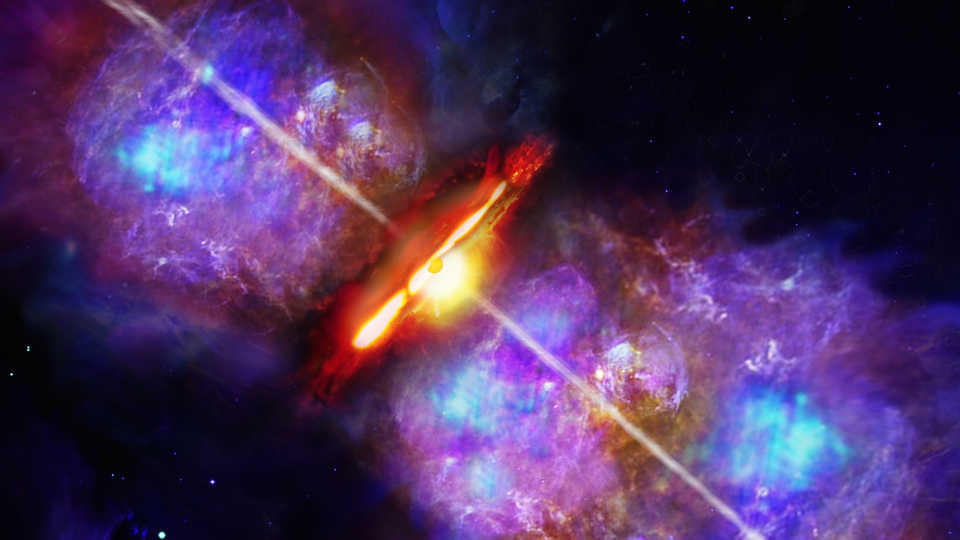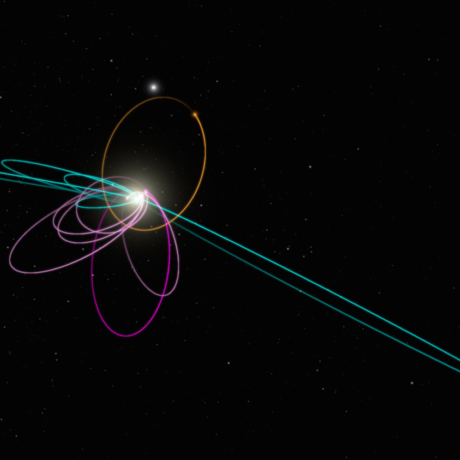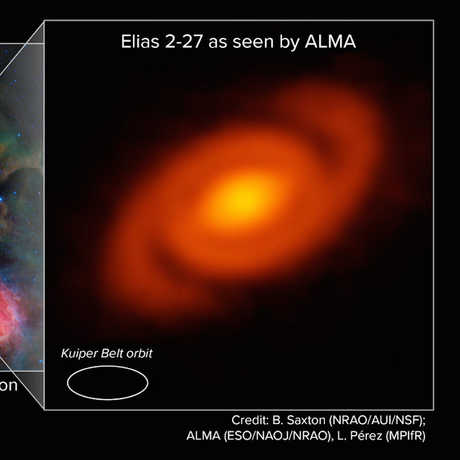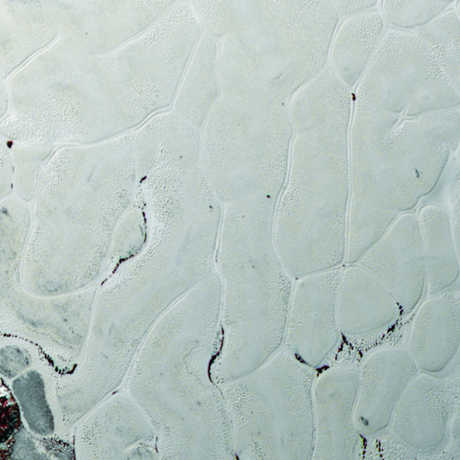Science News
Pluto's Icy Heart, a Star is Born, and a Hidden Supercluster

Pluto’s Slushy, Wandering Heart
We used to think that Pluto was a cold, solid, inactive place, but it turns out Pluto is a lot more active than we expected! As Aaron White wrote in September, some initial studies of New Horizon’s data show a possible subsurface ocean on Pluto. This ocean was thought to be underneath the left side of the dwarf planet’s bright heart-shaped region, an elliptical area named Sputnik Planitia (formerly Sputnik Planum). This week, two new papers published in the journal Nature reveal more evidence for this subsurface ocean, as well as describing how Sputnik Planitia ended up in its current location.
Pluto’s heart points almost exactly in the opposite direction of Pluto’s largest moon Charon. Pluto and Charon are tidally locked with one another, meaning that if you were to stand on Pluto and look at Charon, or vice versa, you’d always see the same side of the neighboring body. This is why we always see the same side of our moon: it’s tidally locked with the Earth. In the dwarf planet’s case, scientists thought this tidal interaction had something to do with the location of Pluto’s heart, but couldn’t understand why.
The first of the two papers focuses on how this might be due to Pluto’s surface wandering over time. Pluto has an extreme tilt that causes it to be almost completely on its side as it orbits the Sun. The dwarf planet’s poles experience freezing winters and (relatively) warmer summers due to its extreme tilt. During the summer, frozen nitrogen can heat up and turn to gas, which travels elsewhere on Pluto and then can fall as nitrogen snow above the cold Sputnik Planitia region. Imagine nitrogen snow falling on you this winter! But don’t imagine too hard, that would also mean temperature would have to plummet to –240°C (–400°F), brrrrr! Over millions of years, this snowfall could build up a large layer of nitrogen on the heart. This buildup of nitrogen adds an excess mass that eventually led to Pluto reorienting itself, with the heart opposite to Charon. To maintain its balance, Pluto “wants” this build up on its heart to prevent wobbling and tipping over its axis. So Pluto may have completely re-arranged its surface because of weather.
The second paper considers the possibility of nitrogen glaciers sliding into the basin from mountain ranges nearby. But if the excess mass is just frozen nitrogen, it would require a ridiculous amount—a nitrogen layer about 40 kilometers (25 miles) deep! Since liquid water is more dense than frozen nitrogen, it’s much more likely that an ocean exists below a layer of nitrogen—about six kilometers (four miles) thick—providing the extra mass needed. But liquid water would require heat. The study’s authors found that Pluto does still have some heat, about 2 percent of what Earth emits, which seems miniscule, but researchers had thought that Pluto would have cooled off completely by now, so any residual warmth is rather surprising. This small amount of heat, along with the pressure underneath Pluto’s surface, would be enough for an ocean, but a very different one than Earth’s—without flowing water (or surfer bums). Pluto’s ocean is probably more akin to a slushy you find at the corner 7-Eleven®. And, given that there are other Kuiper Belt objects out by Pluto with similar size and density, there could be other chilly worlds with slushy oceans as well.
One thing is for certain, Pluto is a much more active dwarf planet than was expected. Between nitrogen snowfall, slushy oceans, reorienting surfaces, flowing glaciers, and more, New Horizon’s data has brought a lot of surprises! The surprises aren’t likely to stop, either. We now have all of New Horizon’s data from Pluto to explore further, as well as data to come from other Kuiper Belt objects in 2019. –Mary Holt
Birth of a Superstar
“The candle that burns twice as bright, burns half as long.” This sentiment is often attributed to stars on the silver screen, but rings even more true to the stars in the sky. We know that more massive stars burn through their fuel exceedingly quickly compared to their less massive counterparts. And when these massive stars go out with a bang, their light output can swamp the brightness of whole galaxies. While these endings are spectacular, new attention has been given to the beginnings of these supermassive stars.
Looking around 6,000 light years away from Earth, we find the star S255IR NIRS 3, a developing star “with a mass estimated at about 20 times the mass of our sun,” according to Alessio Caratti o Garatti of the Dublin Institute for Advanced Studies. As big and bright as this star may be, there is difficulty in viewing it and others like it. This infant star is still enshrouded within its parent cloud. The matter and debris in the surrounding area blocks nearly all of the visible light emitted by even these high-powered stars. However, using tools such as the Near-infrared Integral Field Spectrograph (NIFS), teams of scientists including those at the Gemini Observatory, have been able to pierce the veil and peek at these mysterious stars. And the astronomers find that the early life of these stars may have an explosive quality all their own.
As stars form, they often pull in large amounts of material that isn’t absorbed into the star itself. Instead a small percentage of the total “stuff” flattens, surrounding the star and swirling into a disk. However, that disk isn’t perfectly uniform. Like pancake batter that hasn’t been thoroughly mixed, the disk can include massive clumps of matter. When these clumps (some of which are twice as massive as Jupiter) and stars such as S255IR NIRS 3 meet, the reaction is explosive. “These outbursts, which are several orders of magnitude larger than their lower mass siblings, can release about as much energy as our sun delivers in over 100,000 years,” according to Caratti o Garatti. That’s a lot of wattage! –Tim Goble
A Supercluster in Our Blind Spot
A team of scientists recently found a huge concentration—a supercluster—of galaxies 800 million light years away. What exactly is a supercluster? Hundreds or thousands of galaxies group together in clusters—cosmic structures millions to tens of millions of light years across. A group of these clusters is a supercluster, which, in full, can stretch hundreds of millions of light years across space. Just to give you an idea of what that means, 100 million light years is about 946,073,000,000,000,000,000 kilometers (587,863,000,000,000,000,000 miles). That is 946 quintillion kilometers—a daunting road trip!
If these superclusters are so large and impressive, why has it taken us so long to find this one? Well, this supercluster is right smack dab in the middle of our “blind spot.”
As we look deep out into the cosmos and attempt to map our way through the space that surrounds us, we are inevitably confronted with our limitations as observers. To see an object, we need time for its light to reach us (for example, a flashlight that turns on a light year away won’t be observed for a year while its light travels to us), and we can only see these objects in such clarity as the quality of our telescopes can provide (that flashlight a light year away is probably too far away and too faint for even our best telescopes). We can also only see objects that are not blocked by other materials in our view, which is why our knowledge of galaxies beyond our own has fleshed out into a very hourglass-esque shape. The seemly empty regions surrounding the middle of the hourglass do not represent a real absence of material in those regions, but rather a significant blind spot that lines up well with the plane of our Milky Way Galaxy, where a large quantity of gas and dust in our neighborhood gets in the way of us viewing much outside of it. Because of this, astronomers have nicknamed the plane of the Milky Way as the Zone of Avoidance. Do not look in that direction, because you’re likely wasting telescope time.
The newly discovered supercluster is located in our southern sky, near the constellation of Vela, which meanders through the southern crawl of the Milky Way. This Vela Supercluster has been recognized—despite its awkward position near the Zone of Avoidance—through the efforts of a global team of scientists from South Africa, Germany, Australia, and the Netherlands. Using spectroscopic observations from two instruments in the southern hemisphere, the Anglo-Australian Observatory AAOmega spectrograph and Two Degree Field system (AAOmega+2dF) and the Southern African Large Telescope (SALT), the team peered at the Vela region, edging as close as they dared to the plane of the Milky Way. As a result, they found an overabundance of galactic clusters poking up from the top and bottom of the troublesome zone—a trail of clusters and walls that likely connects behind the Milky Way to form a largescale supercluster that covers about four times the area of the sky as the Big Dipper—that’s a huge swath of the sky! Even though the supercluster also lies hundreds of millions of light years away, this behemoth’s size means it affects the motions of the Local Group of galaxies, including our own Milky Way, because of its incredible mass and corresponding gravitational might. Present estimates have this supercluster adding 50 kilometers per second (or 31 miles per second) to the Local Group’s movement.
In their paper, the scientific team called the Vela Supercluster a “Terra Incognita, an unknown great continent in the nearby Universe.” It is certainly a new land that has just popped up on our known cosmic horizon, whose influence we have likely already felt for quite a long time in the form of gentle gravitational tugs. It will be exciting to get to know this neighbor more in the coming years as we point our telescopes in the direction of our blind spot and endeavor to see what lies beyond. –Eric Edelman
Image: Deutsches SOFIA Institut (DSI)


